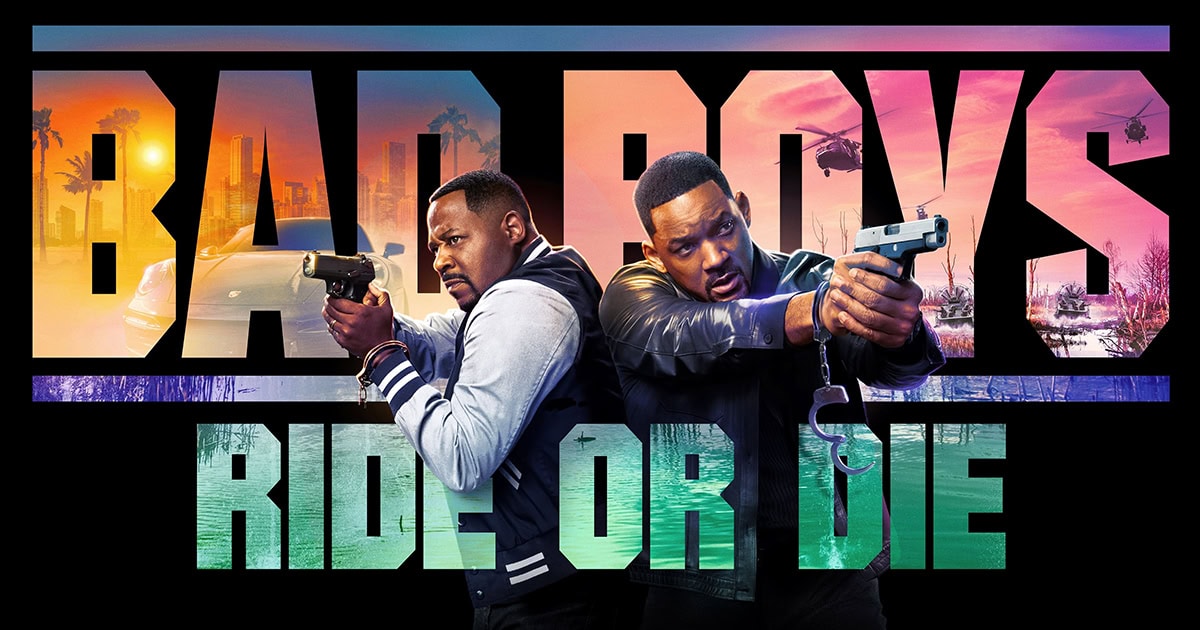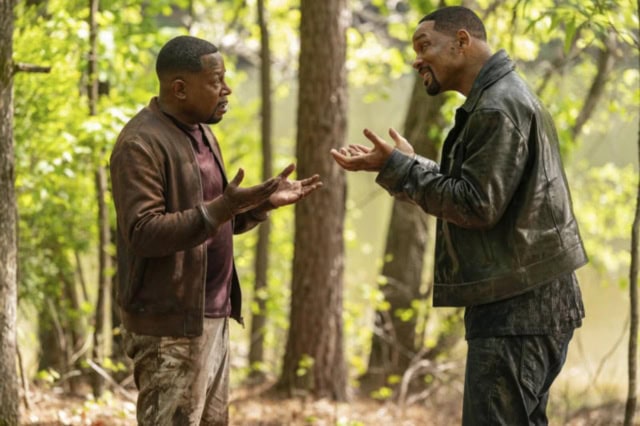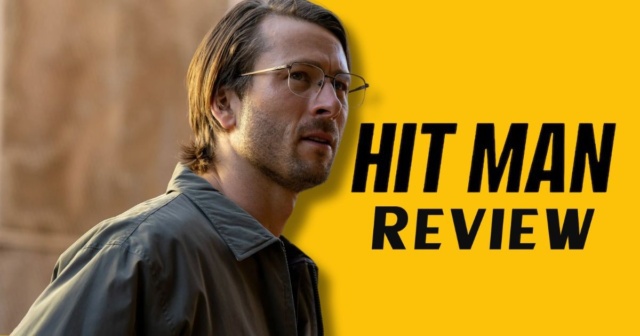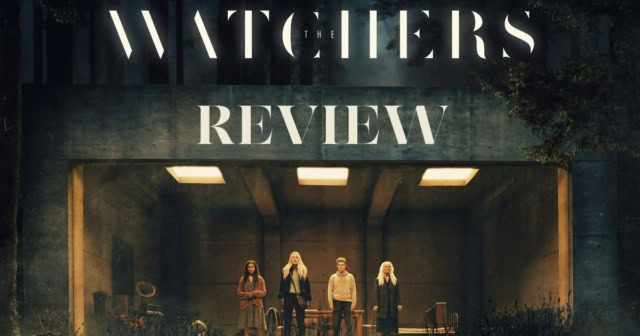‘Bad Boys: Ride or Die’ Movie is a True Work of Action Art

In the first scene of Bad Boys: Ride or Die, it doesn’t take long for directors Adil El Arbi and Bilall Fallah to pull out camera tricks that will ultimately serve the film’s aesthetic during its action-heavy last hour. Marcus Burnett (Martin Lawrence) stops to get a ginger ale at a corner shop and stumbles upon hot dogs (yes, “are those dogs fresh?”) and as he tells the cash register to hurry up, cinematographer Robrecht Heyvaert crafts a shot from the inside of Marcus’ watch to amp up the tension before Mike Lowrey (Will Smith) shows up. But then, this exchange gets interrupted by a robber, who points his gun straight at Marcus’ face from the point of view of the weapon.
[Warning: Spoilers for Bad Boys: Ride or Die below!]
This jolt of energy from the get-go signals to the audience that this Bad Boys movie will be all killer, no filler, and will contain never-before-seen images that will immediately make your jaw drop (or lean forward to the screen). The movie then slows down to set up its main plot; that is, until Adil & Bilall surprise us by throwing a spiritually-charged dream sequence, intricately cut by editors Dan Lebental and Asaf Eisenberg. Here, Marcus experiences a vision of the late Captain Conrad Howard (Joe Pantoliano), while he sees his life flash before his eyes.
The last movie in the franchise, Bad Boys for Life, commented on the stars’ (and characters’) aging bodies as they team up with younger, hotter agents (portrayed by Alexander Ludwig and Vanessa Hudgens, who reprise their roles here). Bad Boys: Ride or Die grabs our attention through a potent mediation on mortality and how “our time” isn’t defined by what we’re doing now, but by what we do with what remains of our lives, as we never know when it’ll be the end.
What starts out as a running gag which sees Marcus believe he can’t die (since it’s not “his time”) rapidly turns into a commentary on choosing to live a little more, perhaps even on the edge, or else what we’re doing may not be worth the time we spend on this green Earth. Some jokes involving this don’t land as well as they should, but Lawrence’s earnestness and passion for the character shine through. So does his physical comedy skills, those haven’t lost a touch since Michael Bay‘s Bad Boys II, which remains the best in the franchise (and Bay’s masterpiece).
Bad Boys: Ride or Die plot summary
The movie quickly sets into gear, with corrupt DEA officer James McGrath (Eric Dane) moving dirty money into Howard’s bank account. This prompts the Miami Police Department to launch an internal investigation that posthumously accuses the late Captain of corruption, working hand-in-hand with the cartel. Of course, Mike and Marcus believe he is innocent and will do anything to clear his name, including talking to Mike’s estranged son, Armando Aretas (Jacob Scipio), to identify who is responsible for pinning the money on Howard.
But as Armando is the only one who can correctly state who it is, he gets attacked in prison. Mike asks leading mayoral candidate Adam Lockwood (Ioan Gruffudd) to move him away and put him in custody in Miami, awaiting trial. In a true bravura sequence, McGrath attacks the helicopter, officially making Mike, Marcus, and Armando fugitives from the law, with Marshall Judy Howard (Rhea Seehorn, playing Conrad’s daughter) determined to catch them and kill Armando for having murdered her father.
The cinematic electricity begins during a scene where Marcus and Mike enter an art gallery to meet up with Fletcher (John Salley, reprising his role from Bay‘s Bad Boys). However, the meeting goes horribly wrong as McGrath and his goons begin to shoot up the place. Beautifully lit with striking neon colors, Adil & Bilall attempt to dynamize the action scene with FPV drone photography, a clear nod to Bay‘s Ambulance, giving unique forms of movement that the scene otherwise wouldn’t have. It also deftly blends Lawrence‘s physical comedy prowess with Barry White‘s “Can’t Get Enough Of Your Love Baby,” playing as Jelly Beans fall on Marcus (which he attempts to eat but lands on a licorice-flavored one everyone hates).
Bad Boys: Ride or Die puts the flow in flowmatic
But it isn’t until the film’s impeccable helicopter scene that Adil & Bilall’s flowmatic approach to action cinema completely solidifies itself. The camera continues to tilt (in 360 degrees), while FPV drones give scope and raise the emotional stakes of the action, as Mike, Marcus and Armando need to work together to land the helicopter before it crashes safely. What’s particularly impressive about its direction is never how Adil & Bilall will emulate Michael Bay, but how they will tip the hat to the filmmakers who helped them solidify their kinetic style of action that is decidedly their own.
Adil & Bilall can’t do Michael Bay. Only Michael Benjamin Bay can deliver true Bayhem, and they are fully aware of this. But they do know how to pay tribute to him and elevate their singular approach to filmmaking by doing so. They have the classic “shit’s just got real” revolving shot of both Smith and Lawrence on a highway right after they film Smith‘s “hero run” slow-motion shot, which are the only two images that are absolutely Bay‘s and appropriated by the two Belgian filmmakers. Yet, they pull off something in the final act that no filmmaker could’ve ever come up with: first-person views of guns, missiles, and even oxygen tanks guiding the primary movement in frame as Mike and Marcus storm into McGrath’s base.
This leads to the movie’s best action sequence, where Adil & Bilall pull out all stops to dazzle audiences in its visual amalgamation worthy of Guy Ritchie and Michael Bay. Will Smith even manipulates the “gun POV” camera, which creates an even more impressive sense of kinetics as he embraces the camera, not for a comeback, but acting as a reminder of the star he is and has always been. We do get a self-reflexive slap joke, which is the only one I’ll accept since Smith gives pause on the worst period of his career without winking at the audience egregiously.
These never-before-seen images are at the heart of Bad Boys: Ride or Die, always trying to find new ways to capture action and give its emotional stakes weight (such as the drone-shot scene where Dennis Greene’s Reggie becomes that guy), making it more of an action art piece than George Miller‘s artificial Furiosa: A Mad Max Saga.
Will Smith and Martin Lawrence are excellent
In Bad Boys: Ride or Die, we feel every hit, punch, and panic attack. This gives Mike texture, going from the quasi-invincible hero in Michael Bay‘s films to a vulnerable, broken man who attempts to pick his pieces back up by living more and keeping the past where it’s supposed to be. In turn, Will Smith gives his best portrayal of Lowrey yet, a layered, ruminative turn as his age makes him think about his difficult life. Frequently flashing back to the first two Bad Boys films, while also having difficulty grappling with the fact that his son murdered Captain Howard.

It’s only natural to find out that the chemistry between Smith and Lawrence pops off the screen, but the same can’t be said for its one-note, predictable, and lackluster antagonists. Without spoiling anything, when a certain actor appeared on screen, I immediately said, “he’s a bad guy; just look at him,” to the friend I was with. The demeanor alone (and character trait) completely revealed it to me.
And yet, when that character is revealed as a secondary antagonist, Adil & Bilall decide to elevate the script’s most clichéd note with another impeccably shot sequence set in an elevator. The camera begins to rotate outside its structure in 360 degrees, the biggest visual nod to the Haitian gang shootout scene in Bad Boys II, the greatest and most innovative action scene of Bay’s career. This makes the reveal way more impressive than it is on paper. It excites us to see filmmakers elevate tepid material just by doing something different from a visual perspective, constantly grabbing our attention no matter the inconsistencies we may feel in the script.
McGrath’s arc can’t be salvaged by neat camera tricks. Dane’s performance doesn’t inspire much menace as Tchéky Karyo in the original Bad Boys or Jordi Mollà in Bad Boys II, even if he’s always one step ahead of the protagonists. His limited screen time never lets us properly latch onto the character, or at least understand his motivations, making him more of a “villain of the week” type character than a fully-fledged antagonist that menaces the safety of both protagonists. But it’s about the only glaring flaw that Adil & Bilall‘s film contains, one that’s bursting with creativity at every turn, reminding us all how powerful an action scene can be.
Cinema is an art form, and many filmmakers have lost their ability to create powerful images that stick with us long after the film ends. Studio CEOs have turned the tables and called it “content,” which devalues the artistic merit of cinema. There’s nothing more anti-art, and it’s partly why the visual medium of cinema has been completely diminished by filmmakers who look at cinema as a commodified piece of intellectual property rather than art.
Audiences are content to accept grey-sludged-constructed action scenes because they’ve not been taught how a camera can produce lively colors and move in ways you’ve never seen before. Inspired by Michael Bay‘s revolutionary filmmaking techniques, Adil El Arbi and Bilall Fallah will teach audiences to look at action cinema differently and perhaps bring the kinetic energy needed to revitalize the summer box office after a dreary start. Bad Boys for Life, baby.
Bad Boys: Ride or Die is now playing in theaters. Have you seen it yet? Let us know what you think on social media @mycosmiccircus or in The Cosmic Circus Discord.
Hit Man Review: The Perfect Rom-Com Crowd Pleaser
The Watchers is Conventional, but Ishana Shyamalan Shows Promise




